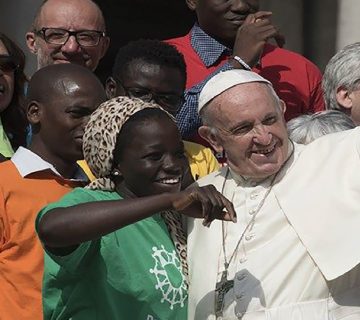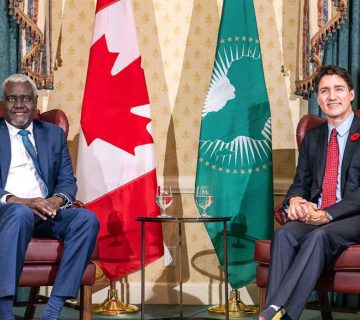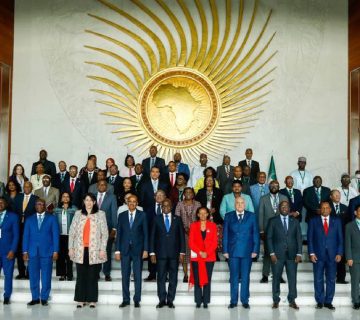On April 28, 2012, the five East African Heads of state signed a protocol for Cooperation in Defence affairs in Arusha, Tanzania. This was after an elaborate process of many meetings that sought to iron out the gray areas of legal and administrative diversity among individual member states. What started as a policy framework developed into an MOU, an Agreement, and eventually into a Protocol. Article 2 of the protocol covers the scope of cooperation and without prejudice to the generality of the article, the Partner States agreed inter alia to cooperate in military training, joint operations, technical cooperation, visits, and exchange of information.
The objectives as set out in the protocol can be summarized as promotion of policies that seek to deepen and widen cooperation, promote peace, security and stability and good neighborliness among member states, prevention of conflicts and reestablishment of peace where conflict has occurred, peacebuilding and post-conflict reconstruction, prevention and combatting international terrorism and any other task that may arise within the sphere of cooperation. This protocol, therefore, seeks to address the delicate balance between individual States’ foreign policies and the need for regional cooperation in pursuit of common regional interests.
The military is one of the three instruments of Foreign Policy, the other two being Political and Economic. So, how does military cooperation work in a region that has quite distinct national Foreign Policies? In the East African Community (EAC) region, we find countries with isolationist policies, autocratic politics, expansionist tendencies, and outright ethnically oriented civil conflict. Some member states have even gone ahead to form a “coalition of the willing” thereby isolating others from development plans. How is the military expected to pursue cooperation in an environment of a cold political relationship? Well, it is no easy task. But just like war, resilience and focus are required advance given objectives.
In fact, the regional military has well drawn out a calendar of events for annual, and periodic joint activities. Notwithstanding the political adversity between some member states, these activities are always undertaken. These include joint exercises, sporting and cultural exchange, student exchange programmes in each other’s military schools, colleges, and academies, cross border disaster response, high-level visits and free assisted passage through each other’s territory.
The underlying factor in the cooperation is the cordial relationship that has been developed among the Defence Forces of member States. This state of affairs has greatly defused the suspicions that used to exist among the Forces and States before the said cooperation. It has also created a deterrent effect against any nonmember with temptations of aggression against a member state. But does the protocol say so? Not necessarily, but deterrence is about perceptions and posturing. When forces train together, it is assumed that they will fight together should the need arise.
The main issues in the protocol have been capacity. As much as we would wish to see equality of states, regional Defence Forces are not equal in capacity in terms of training, equipment, moral orientation, and personal strength. Member States also differ in their constitutional provisions for deployment of Defence Forces. Defence Forces training is normally mission oriented and not for training’s sake. While regional Defence forces conduct joint training on thematic areas of peacekeeping, disaster management, and counter-terrorism, it remains a political decision to be made by member States as to whether and how their Defence Forces would conduct operations in the territory of another member State. Authorization process for such operations could take long as seen even during the ratification of the protocol. Some members felt like they were ceding too much to the Regional organization while others felt like it would be too much of a national burden. Others felt like they could be sucked into another member State’s internal affairs, while still others felt the joint events would be very expensive to participate. All these issues create apathy and disruptions in calendar events. However, through cadre meetings, negotiations, dialogue, and high-level engagements, many challenges have been overcome and the cooperation kept on course. By and large, internal political activities within member States have not greatly affected the spirit and letter of the protocol. In some instances, assistance has been extended to member States that had expressed reservations that could have denied them participation in Joint activities.
The overall effect of the EAC Cooperation in Defence Affairs is the perceived trust, friendship, and stability caused by the cooperation of the Regional Defence Forces without which suspicion could have taken the place of information sharing and mutual assistance in training and disaster response. With new members like South Sudan poised to join the EAC, challenges abound ranging from the instability of the Member State to unprofessional military. Maybe more military-to-military engagements could help break the impasse of ethnically divided South Sudanese military and hence pave way for political dialogue.
The current protocol covers cooperation only in Operations Other Than War (OOTW). There are however new and emerging threats to human security that definitely attract military attention. These include small arms proliferation, cross-border crimes, human and drug trafficking. Although these may appear like criminal activities which fall within the police area of responsibility (AOR), they threaten the very integrity and stability of a nation for which the military is established to protect. Future outlook for the cooperation should, therefore, develop the protocol into a bold Defence Pact that declares “an enemy to one is an enemy to all”. This would create a grater and credible deterrence not only from outside the region but also intra-region and intra-state threats to peace and security. The Pact may also provide for intervention and preemptive deployment by the regional force to prevent genocide or a human catastrophe. The process and procedures for deploying such force should be clearly defined to ensure timely action. This also calls for an active Conflict Early Warning (CWERN) infrastructure, linked to the EAC Secretariat in order to facilitate the requisite decision making in good time.
By Brig Gen (Rtd) George G.Kabugi is a Defence and Security expert at the HORN Institute.



